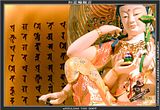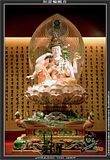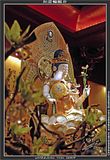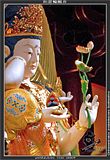
觀音 (Kwan Yin) in a common feminine manifestation in the East.
Avalokiteśvara or 觀音 (in Chinese writing) or अवलोकितेश्वर (in Sanskrit writing) and many more names that we may know of, refers to the same Bodhisattva. Do not be confused as to call Bodhisattva as Avalokiteśvara. Bodhisattva literally translates to "Enlightened Being" who is dedicated to attaining Nirvana, but made a vow never to attain it before 'all beings' are enlightened. It is also easily confused with the gender of Avalokiteśvara, we Asians in the East, always see of Avalokiteśvara in a feminine manifestation, as the Goddess of Mercy dressed in white robes, hand holding a vase and standing on a giant lotus. However, in most Buddhist writings, Avalokiteśvara is referred to as a male.
There is one legend that says Avalokiteśvara was a beautiful princess who forsaken her wealth and marriage, for a life so simple yet so spiritual, devoting to compassion, helping all beings and attaining Nirvana. However, upon achieving enlightenment, and the right to enter Tsushita Heaven, she heard cries of earthly beings. She vowed never to attain Nirvana, and returned to earthly plane to help all beings who are suffering. Thus, referred to as a Bodhisattva.
Another legend says that Avalokiteśvara, despite his many efforts to help all beings to attain enlightenment, there are still too many suffering beings who have yet been saved. Avalokiteśvara was very sad over not being able to reach out to so many beings, but his compassionate heart eventually moved the Amitahba Buddha, who in turn gave him eleven heads to see and hear the cries from distant places, and a thousand arms to reach out to places previously impossible. Thus, the manifestation of 千手 觀音 (Kwan Yin with a thousand arms).
Despite all the different manifestations of Avalokiteśvara, there is eventually one common understanding that refers to Avalokiteśvara as the Compassionate Bodhisattva and all faithful devotees chant the mantra of Avalokiteśvara, ॐ मणि पद्मे हूँ (Om Padme Mani Hum in Sanskrit writing).
Yesterday, I visited the Buddha Tooth Relic Temple & Museum. I have earlier visited this temple during Vesak 2551 Float Parade and other brief occasions. I was captivated by all the splendour of the temple, the very moment I entered the first hall on the the ground level, The Maitreya Buddha Hall (I shall talk more about the Maitreya Buddha and this hall at another time). After admiring the spectacular decorations surrounding the grand Maitreya Buddha statue and the many sponsored Maitreya Gaus. I made my way to the rear of the Maitreya Buddha Hall, into the Cintâmanicakra Avalokiteśvara Bodhisattva Hall.





References
The Bodhisattva Ideal - Buddhism and the Aesthetics of Selflessness
Avalokitesvara on Wikipedia
Avalokiteshvara Buddhist Center in Denver
Om Mani Padme Hum on Wikipedia
Buddha Tooth Relic Temple & Museum
Many thanks to Cedric for sharing with me his knowledge on Buddhism.
Any challenges to the accuracy of this post can be made via your generous comments. Otherwise, please watch my blog for more updates after I revisit the temple again.
technorati tags
Singapore Buddhism Buddha Bodhisattva Buddha+Tooth+Relic+Temple Avalokitesvara
No comments:
Post a Comment